The Methylation and Expression of LINC00511, an Important Angiogenesis-Related lncRNA in Stomach Adenocarcinoma
Abstract
1. Introduction
2. Results
2.1. Analysis of ARlncRNAs in STAD
2.1.1. Construction of ARlncRNAs Prognostic Model
2.1.2. Assessment and Verification of Prognostic Models
2.1.3. an Independent Prognostic Factor for STAD
2.1.4. Analyses of Methylations in ARlncRNAs in Prognostic Models
2.2. LINC00511 Expression and Methylation Analysis
2.2.1. LINC00511 Expression Correlates with Survival in STAD Patients
2.2.2. Analysis of Abnormal DNA Methylation
2.2.3. Clinical Data Statistics of the Expression of LINC00511 for STAD Patients
2.2.4. The Relationship of LINC00511 and miRNA/mRNA
3. Discussion
4. Materials and Methods
4.1. Screening ARlncRNAs
4.2. Identification of Prognostic Features
4.3. Analysis of Prognostic Features
4.4. Methylation Analysis
4.5. Chi-Squared Test
4.6. Target Gene Prediction
4.7. Statistical Analysis
5. Conclusions
Supplementary Materials
Author Contributions
Funding
Institutional Review Board Statement
Informed Consent Statement
Data Availability Statement
Acknowledgments
Conflicts of Interest
Abbreviations
| SC | stomach cancer |
| STAD | stomach adenocarcinoma |
| lncRNA | long non-coding RNA |
| ARgene | angiogenesis-related gene |
| ARlncRNA | angiogenesis-related long non-coding RNA |
| KM | Kaplan–Meier |
| ROC | receiver operating characteristic curve |
| AUC | area under the curve |
| OS | overall survival |
| GCA | gastric cardia adenocarcinoma |
| miRNA | microRNA |
| GO | Gene Ontology |
| KEGG | Kyoto Encyclopedia of Genes and Genomes |
References
- Han, B.; Zheng, R.; Zeng, H.; Wang, S.; Sun, K.; Chen, R.; Li, L.; Wei, W.; He, J. Cancer incidence and mortality in China, 2022. J. Natl. Cancer Center 2024, 4, 47–53. [Google Scholar] [CrossRef] [PubMed]
- Ajani, J.A.; Lee, J.; Sano, T.; Janjigian, Y.Y.; Fan, D.; Song, S. Gastric adenocarcinoma. Nat. Rev. Dis. Primers 2017, 3, 17036. [Google Scholar] [CrossRef]
- Xi, T.; Zhou, Y.B.; Ma, S.; Lu, W.; Sun, Y.; Sun, C.; Zhou, Y. Construction of a potential long noncoding RNA prognostic model involved competitive endogenous RNA for patients with gastric cancer. Medicine 2024, 103, e38458. [Google Scholar] [CrossRef] [PubMed]
- Onetti, Y.; Kälin, R.E.; Pitter, B.; Hou, M.; Arribas, V.; Glass, R.; Montanez, E. Deletion of endothelial α-parvin inhibits tumour angiogenesis, reduces tumour growth and induces tumour cell apoptosis. Angiogenesis 2022, 25, 155–158. [Google Scholar] [CrossRef]
- Liang, J.; Cheng, Q.; Huang, J.; Ma, M.; Zhang, D.; Lei, X.; Xiao, Z.; Zhang, D.; Shi, C.; Luo, L. Monitoring tumour microenvironment changes during anti-angiogenesis therapy using functional MRI. Angiogenesis 2019, 22, 457–470. [Google Scholar] [CrossRef] [PubMed]
- Sexton, R.E.; Al Hallak, M.N.; Diab, M.; Azmi, A.S. Gastric cancer: A comprehensive review of current and future treatment strategies. Cancer Metastasis Rev. 2020, 39, 1179–1203. [Google Scholar] [CrossRef] [PubMed]
- Smith, M.G.; Hold, G.L.; Tahara, E.; El-Omar, E.M. Cellular and molecular aspects of gastric cancer. World J. Gastroenterol. 2006, 12, 2979–2990. [Google Scholar] [CrossRef] [PubMed]
- Pi, Y.; Qi, W.; Xia, B.; Lou, G.; Jin, W. Long non-coding RNAs in the tumor immune microenvironment: Biological properties and therapeutic potential. Front. Immunol. 2021, 12, 697083. [Google Scholar] [CrossRef] [PubMed]
- Han, C.; Zhang, C.; Wang, H.; Li, K.; Zhao, L. Angiogenesis-related lncRNAs predict the prognosis signature of stomach adenocarcinoma. BMC Cancer 2021, 21, 1312. [Google Scholar] [CrossRef]
- Xu, P.; Liu, S.; Song, S.; Yao, X.; Li, X.; Zhang, J.; Liu, Y.; Zheng, Y.; Gao, G.; Xu, J. Identification and validation of a novel angiogenesis-related gene signature for predicting prognosis in gastric adenocarcinoma. Front. Oncol. 2023, 12, 965102. [Google Scholar] [CrossRef]
- Gong, Q.; Huang, X.; Chen, X.; Zhang, L.; Zhou, C.; Li, S.; Song, T.; Zhuang, L. Construction and validation of an angiogenesis-related lncRNA prognostic model in lung adenocarcinoma. Front. Genet. 2023, 14, 1083593. [Google Scholar] [CrossRef] [PubMed]
- Biagioni, A.; Peri, S.; Versienti, G.; Fiorillo, C.; Becatti, M.; Magnelli, L.; Papucci, L. Gastric cancer vascularization and the contribution of reactive oxygen species. Biomolecules 2023, 13, 886. [Google Scholar] [CrossRef] [PubMed]
- Aspriţoiu, V.M.; Stoica, I.; Bleotu, C.; Diaconu, C.C. Epigenetic regulation of angiogenesis in development and tumors progression: Potential implications for cancer treatment. Front. Cell Dev. Biol. 2021, 9, 689962. [Google Scholar] [CrossRef] [PubMed]
- Li, N.; Zeng, A.; Wang, Q.; Chen, M.; Zhu, S.; Song, L. Regulatory function of DNA methylation mediated lncRNAs in gastric cancer. Cancer Cell Int. 2022, 22, 227. [Google Scholar] [CrossRef] [PubMed]
- Wang, J.; Jin, Y.; Wu, P.; Liu, Y.; Zhao, W.; Chen, J.; De, W.; Yang, F. Tumor suppressor PLZF regulated by lncRNA ANRIL suppresses proliferation and epithelial mesenchymal transformation of gastric cancer cells. Oncol. Rep. 2019, 41, 1007–1018. [Google Scholar] [CrossRef] [PubMed]
- Sun, M.; Xia, R.; Jin, F.; Xu, T.; Liu, Z.; De, W.; Liu, X. Downregulated long noncoding RNA MEG3 is associated with poor prognosis and promotes cell proliferation in gastric cancer. Tumor Biol. 2014, 35, 1065–1073. [Google Scholar] [CrossRef]
- Zhu, F.; Zhang, S.; Wang, L.; Wu, W.; Zhao, H. LINC00511 promotes the progression of non-small cell lung cancer through downregulating LATS2 and KLF2 by binding to EZH2 and LSD1. Eur. Rev. Med. Pharmacol. Sci. 2019, 23, 8377–8390. [Google Scholar]
- Lu, M.; Gao, Q.; Wang, Y.; Ren, J.; Zhang, T. LINC00511 promotes cervical cancer progression by regulating the miR-497-5p/MAPK1 axis. Apoptosis 2022, 27, 800–811. [Google Scholar] [CrossRef]
- Wang, R.; Jiang, J.; Jiang, T.; Wang, Y.; Chen, L. Increased long noncoding RNA LINC00511 is correlated with poor prognosis and contributes to cell proliferation and metastasis by modulating miR-424 in hepatocellular carcinoma. Eur. Rev. Med. Pharmacol. Sci. 2019, 23, 3291–3301. [Google Scholar]
- Buckland, G.; Travier, N.; Huerta, J.; Bueno-De-Mesquita, H.; Siersema, P.; Skeie, G.; Weiderpass, E.; Engeset, D.; Ericson, U.; Ohlsson, B.; et al. Healthy lifestyle index and risk of gastric adenocarcinoma in the EPIC cohort study. Int. J. Cancer 2015, 137, 598–606. [Google Scholar] [CrossRef] [PubMed]
- Salmena, L.; Poliseno, L.; Tay, Y.; Kats, L.; Pandolfi, P.P. A ceRNA hypothesis: The Rosetta Stone of a hidden RNA language? Cell 2011, 146, 353–358. [Google Scholar] [CrossRef]
- Mitsimponas, N.; Zervopoulos, G. Urinary bladder metastasis from gastric cancer: A case report and review of the literature. Reports 2021, 4, 14. [Google Scholar] [CrossRef]
- Han, D.; Yuan, R.X.; Su, F. LINC00511 can promote the proliferation, migration and invasion of esophageal cancer cells through regulating microRNA-150-5p. Eur. Rev. Med. Pharmacol. Sci. 2020, 24, 2462–2469. [Google Scholar] [PubMed]
- Cui, N.; Sun, Q.; Liu, H.; Li, L.; Guo, X.; Shi, Y.; Jing, C.; Qin, C.; Zhao, Y. Long non-coding RNA LINC00511 regulates the expression of microRNA-625-5p and activates signal transducers and activators of transcription 3 (STAT3) to accelerate the progression of gastric cancer. Bioengineered 2021, 12, 2915–2927. [Google Scholar] [CrossRef] [PubMed]
- Qian, X.; Jiang, C.; Zhu, Z.; Han, G.; Xu, N.; Ye, J.; Wang, R. Long non-coding RNA LINC00511 facilitates colon cancer development through regulating microRNA-625-5p to target WEE1. Cell Death Discov. 2022, 8, 233. [Google Scholar] [CrossRef] [PubMed]
- Liu, C.; Xu, Y.; Liu, X.; Fu, Y.; Zhu, K.; Niu, Z.; Liu, J.; Qian, C. Upregulation of LINC00511 expression by DNA hypomethylation promotes the progression of breast cancer. Gland. Surg. 2021, 10, 1418–1430. [Google Scholar] [CrossRef] [PubMed]
- Liu, Y.; Li, Q.; Cao, Y. The effect of key DNA methylation in different regions on gene expression in hepatocellular carcinoma. Mol. Omics 2022, 18, 57–70. [Google Scholar] [CrossRef]
- Lugo-Armenta, J.G.; Pino-Fan, L.R.; Ruiz, B.R. Chi-square reference meanings: A historical-epistemological overview. Revemop 2021, 3, 1–33. [Google Scholar] [CrossRef]
- Cao, S.; Wang, X.; Liu, X.; Li, J.; Duan, L.; Gao, Z.; Lun, S.; Zhu, Y.; Yang, H.; Zhang, H.; et al. Integrative analysis of angiogenesis-related long non-coding RNA and identification of a Six-DEARlncRNA signature associated with prognosis and therapeutic response in esophageal squamous cell carcinoma. Cancers 2022, 14, 4195. [Google Scholar] [CrossRef]


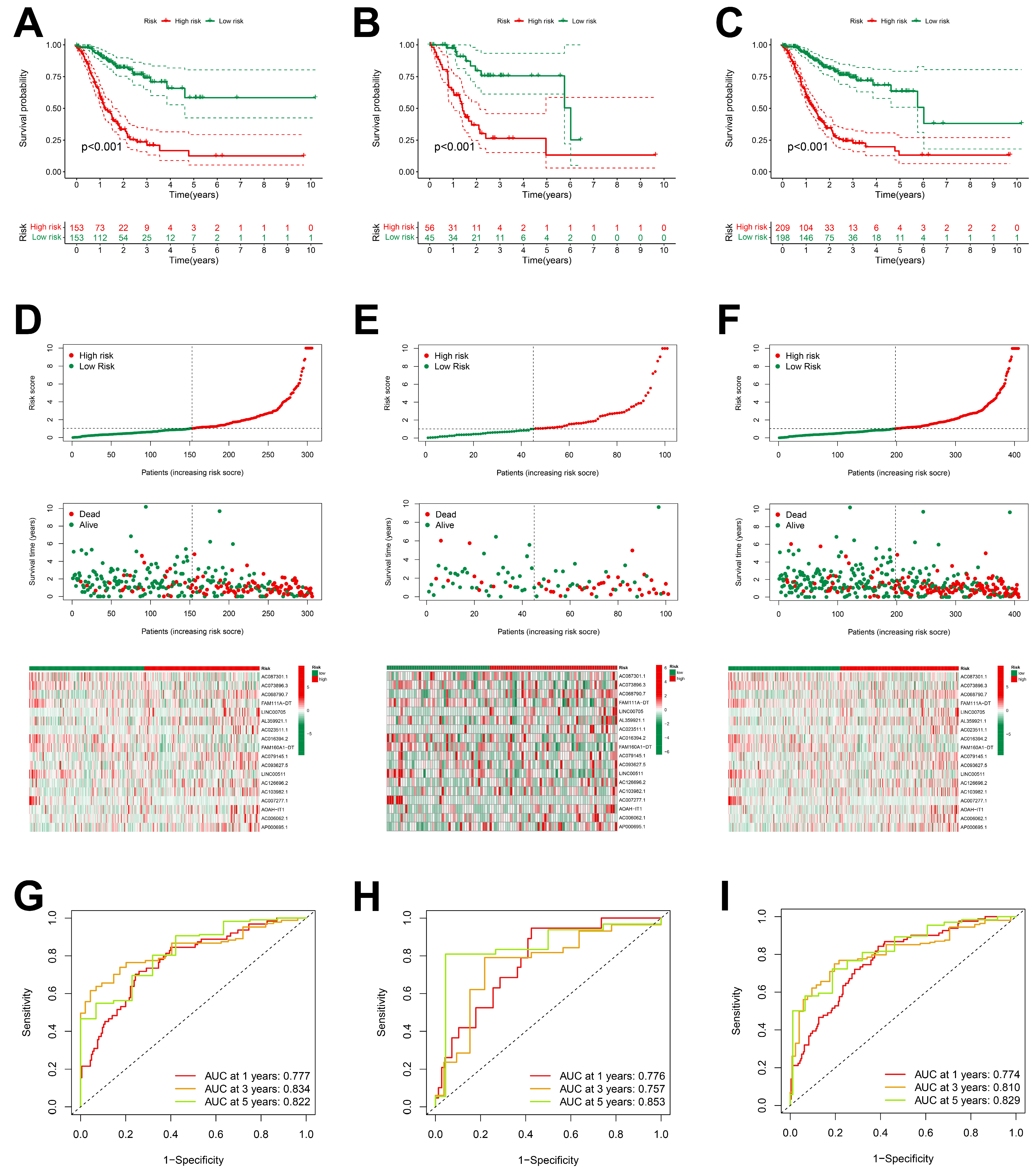
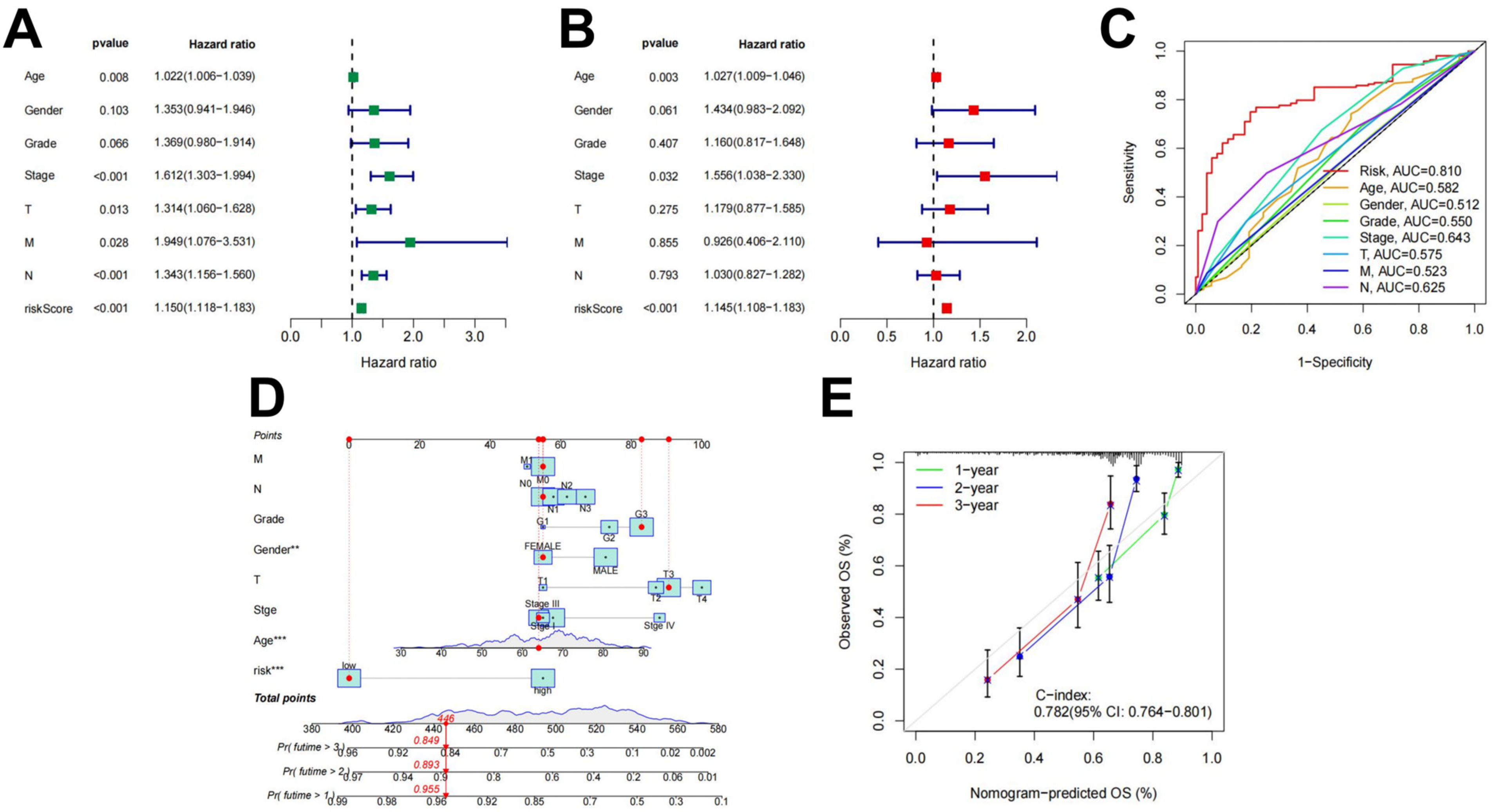


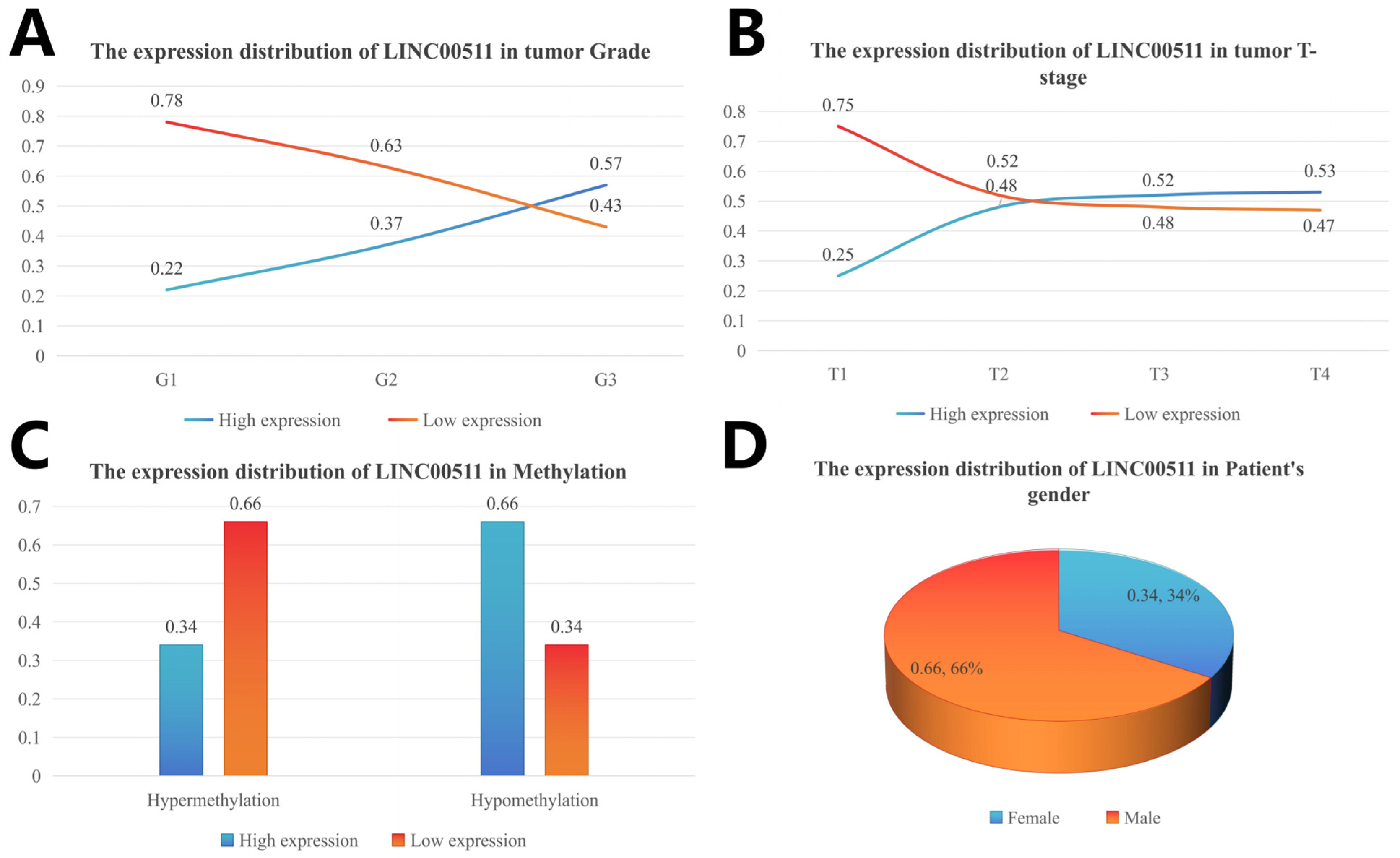
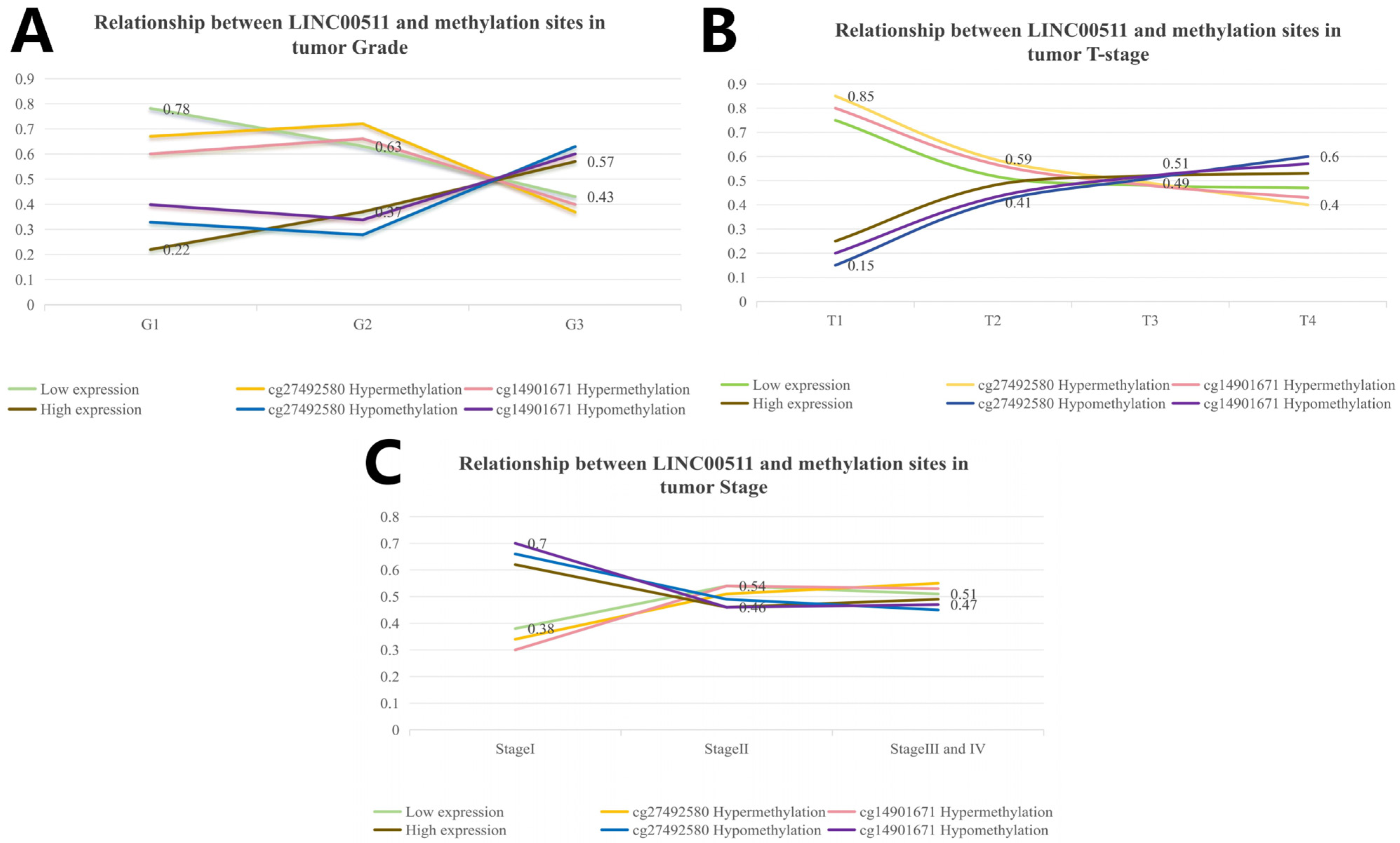
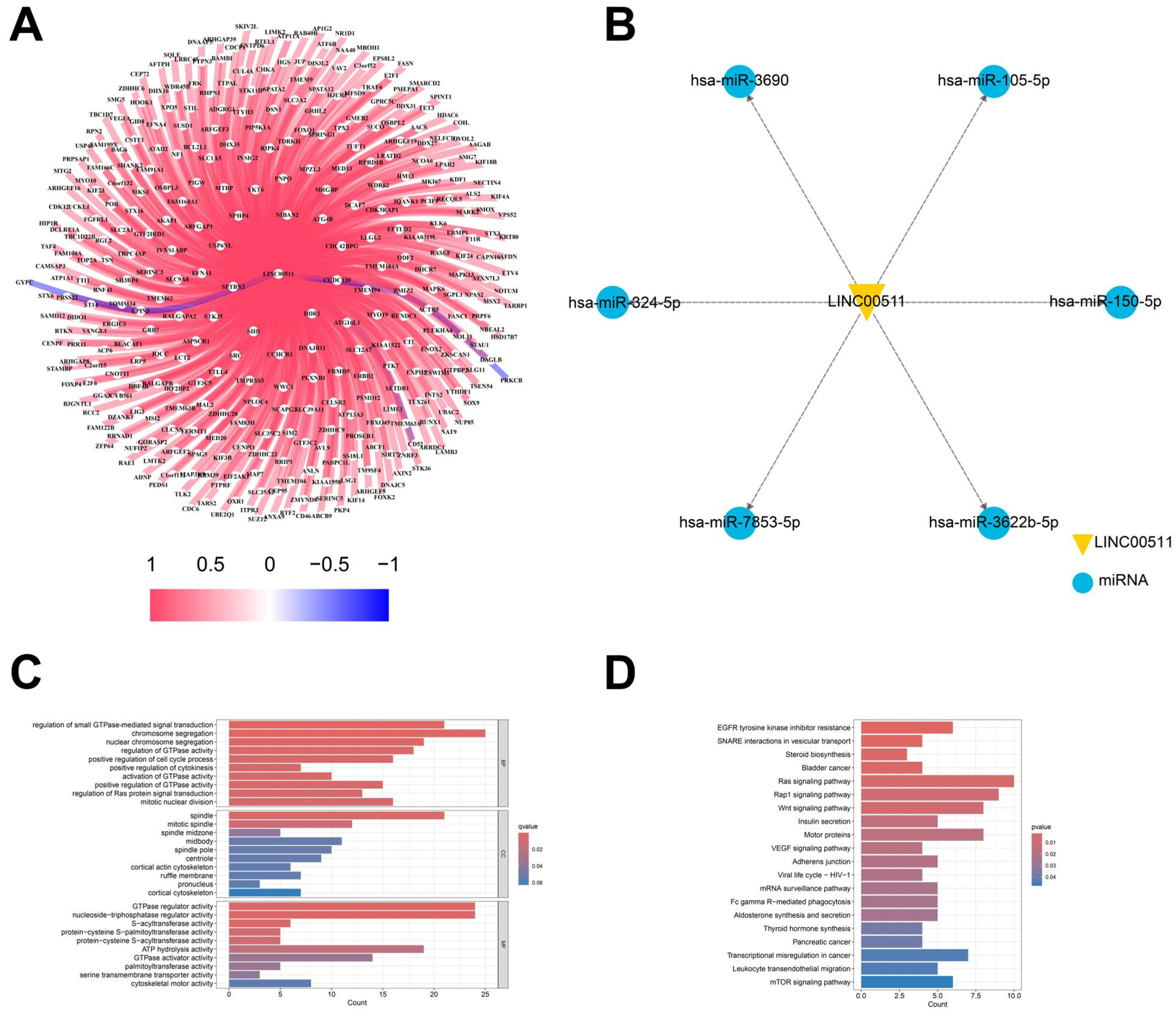
Disclaimer/Publisher’s Note: The statements, opinions and data contained in all publications are solely those of the individual author(s) and contributor(s) and not of MDPI and/or the editor(s). MDPI and/or the editor(s) disclaim responsibility for any injury to people or property resulting from any ideas, methods, instructions or products referred to in the content. |
© 2025 by the authors. Licensee MDPI, Basel, Switzerland. This article is an open access article distributed under the terms and conditions of the Creative Commons Attribution (CC BY) license (https://creativecommons.org/licenses/by/4.0/).
Share and Cite
Li, Z.; Chen, Y.; Zhao, Y.; Li, Q. The Methylation and Expression of LINC00511, an Important Angiogenesis-Related lncRNA in Stomach Adenocarcinoma. Int. J. Mol. Sci. 2025, 26, 2132. https://doi.org/10.3390/ijms26052132
Li Z, Chen Y, Zhao Y, Li Q. The Methylation and Expression of LINC00511, an Important Angiogenesis-Related lncRNA in Stomach Adenocarcinoma. International Journal of Molecular Sciences. 2025; 26(5):2132. https://doi.org/10.3390/ijms26052132
Chicago/Turabian StyleLi, Zhiying, Yingli Chen, Yuanyuan Zhao, and Qianzhong Li. 2025. "The Methylation and Expression of LINC00511, an Important Angiogenesis-Related lncRNA in Stomach Adenocarcinoma" International Journal of Molecular Sciences 26, no. 5: 2132. https://doi.org/10.3390/ijms26052132
APA StyleLi, Z., Chen, Y., Zhao, Y., & Li, Q. (2025). The Methylation and Expression of LINC00511, an Important Angiogenesis-Related lncRNA in Stomach Adenocarcinoma. International Journal of Molecular Sciences, 26(5), 2132. https://doi.org/10.3390/ijms26052132





